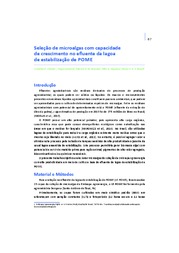Microalgae found in the Cerrado treats the inorganic material of the effluent (pome) produced by African palm oil processing.. High-yield strain (Chlamydomonas biconvexa Embrapa LBA40) was selected from Embrapa Agroenergy's bank Treatment generates biomass that can be used as animal feed, fertilizer, or even as raw material for cosmetic and food industries.. The use of the microalgae accelerates inorganic treatment (from three months to five days) and saves an area of the property that needs to use large waste stabilization ponds in the conventional system.. New process does not need additives and opens up the possibility of income by selling carbon credits. The research sequenced the mitochondrial genome of the species, paving the path for genetic improvement and breeding activities in the future.. The next challenges are tests for industrial production and studies on the most profitable uses of the generated biomass. A type of microalgae selected from the germplasm bank held by Embrapa Agroenergy (Brasília,DF) was successful in the in-laboratory cleaning of inorganic material from Pome (palm oil mill effluent), an effluent generated in the processing of African palm oil, which is known as dendê in Brazil. Chamydomonas biconvexa Embrapa LBA40, microalgae that had been successful in the treatment of sugar-energy industry effluent vinasse, have shown similar performance with African palm oil processing. In only five days the microalgae reduced the amount of Pome phosphate by 98% and the levels of nitrite and ammonia by 99%. A surprising result if compared with the approximate three months that a waste stabilization pond takes to promote similar cleaning. The inorganic material is formed especially by molecules that contain phosphorus, nitrogen, and potassium. In order to not release them in nature, the pome is kept in waste stabilization ponds for weeks so that, through natural processes, they are consumed and separated until the remaining liquid is ready for disposal. A theme since the master's degree of the Bioprocesses and Biotechnology engineer Patrícia Verdugo Pascoal at the Federal University of Tocantins (UFT), the study is part of her ongoing doctoral degree at the Federal University of Bahia (UFBA). The work results have recently been published in the scientific journal Plos One. The performance of this strain opens new perspectives so that the waste stabilization ponds for Pome treatment are replaced by photobioreactors, equipment that allows the effluent to be used as substrate for microalgae cultivation. "It would be a long term investment through the trade of the biomass generated," the engineer clarifies. Another advantage of the microalgae tested is that they do not need any input to consume the chemicals present in the Pome. The production cost is low and upon multiplying they form a valuable biomass for different purposes. "We have found high contents of carbohydrates and proteins in this biomass," informs the Embrapa researcher Bruno Brasil, Pascoal's advisor. He recalls that the biomass has such diversified potential of use that new studies should now analyze the most viable and profitable commercial purposes. The microalgae biomass can be used in the industry of animal feed for fish farming, as fertilizer, and even as a high value input for the cosmetic and food industries (see infographic on the left). "A hypothesis is that it has the potential to be used as a plant growth booster, for example," Brasil declares. Carbon credits Due to the consumption of carbon dioxide (CO2) during the process, the microalgae remove a considerable amount of carbon from the atmosphere. "This paves the path for the sale of carbon credits," the researcher analyzes. as he mentionsthe program from the Brazilian government RenovaBio he emphasizes that "the microalgae have a much higher photosynthesis rate than plants. Thus, the carbon that is biofixed in this process can reward the farmer with carbon credits." The technology employed is also capable of saving space in the property. It happens because a sequence of ponds treat the effluents produced in milling. The last stage is the aerobics pond, the largest one and also the one destined to the dissolution of the inorganic material. "In short, the treatment with microalgae would make the replacement of this pond with photobioreactors possible, which occupy a smaller area. In addition, it would treat the effluent in much less time, produce valuable biomass, and still bring potential for carbon credits trade," the researcher summarizes. Pioneering genetic sequencing The research also involved the sequencing of the mitochondrial genome of Chlamydomonas biconvexa, carried out for the first time. "In addition to corroborate for the identification of the species it offers a new level for the future genetic breeding works on the microalgae," Pascoal states. "Future research will be able to use this molecular data to improve interest characteristics such as higher biomass generation or better performance in effluent treatment, for example," Patrícia Pascoal considers. The challenges are now the pilot scale tests and industrial scale validation of such biomass, as well as characterization and economic viability studies in order to define ends that add value to the chain. An ocean of 200mi t of pome per year The largest source of plant oil in the planet, the processing of oil palm generates an ocean of about 200 million tonnes of effluents every year, a volume that would filll around 80,000 Olympic pools. In 2018, Brazil produced 1.6 milion tones of such palm bunches, according to data by the Brazilian Institute of Geography and Statistics (IBGE). For every liter of oil produced, five to seven liters of effluent are generated. Therefore, the discovery of Brazilian microalgae tat can remove inorganic material from pome paves the way for more sustainability and added value for the country, which takes the 9th place in world's top palm oil producing countries. Palm oil is one of the most productive known plant oils, as it yields more oil per planted area than any other species. The fruit supplies 35% os the world demand for this kind of oil while occupying only 10% of the area. In order to produce the same quantity of oil, soybeans would require an area four times larger, for instance. Photo: iStock/slpu9945 Palm oil's social and economic role is relevant as it drives the GDP of emerging countries and involves an expressive quantity of family farmers in its production system. Its use is so diversified that ranges from cookies to shampoo. Sugarcane inheritance Chlamydomonas biconvexa Embrapa LBA40 was originally found in the vinasse of a sugarcane plant in the Cerrado region. The presence of the microalgae in that effluent pointed to its potential to process this material. Later on, research with vinasse showed that the strain was in fact efficient to treat the sugarcane effluent. "The presence in the vinasse indicated its tolerance to that effluent, which made it a strong candidate for cultivation in Pome," Patrícia Pascoal reports. In the end, LBA40 presented the best performance in the treatment in comparison with other 16 strains tested in the study. African palm oil program to save the forest The work was developed within the project "Dende Palm", by the the Studies and Projects Funding Agency (Finep), and coordinated by Embrapa Agroenergy. The project aims to cover the obstacles of African palm oil production chain that prevent its sustainable growth. African oil palm is a plant from equatorial regions that are warm and humid, which makes its production in Brazil to be concentrated in the Amazon biome, especially in the state of Pará. For this reason, in 2010 the federal government created the Sustainable Palm Oil Production Program (PSOP), establishing that the expansion of the crop should only be made in areas that are already cleared to stop advances over the forest. In this sense, the initiative was successful and the crop that had advanced by 4% over the forest per year dropped this number to about 1% per year in the first four years of implementation.
-
Microalgae found in the Cerrado treats the inorganic material of the effluent (pome) produced by African palm oil processing.. -
High-yield strain (Chlamydomonas biconvexa Embrapa LBA40) was selected from Embrapa Agroenergy's bank -
Treatment generates biomass that can be used as animal feed, fertilizer, or even as raw material for cosmetic and food industries.. -
The use of the microalgae accelerates inorganic treatment (from three months to five days) and saves an area of the property that needs to use large waste stabilization ponds in the conventional system.. -
New process does not need additives and opens up the possibility of income by selling carbon credits. -
The research sequenced the mitochondrial genome of the species, paving the path for genetic improvement and breeding activities in the future.. -
The next challenges are tests for industrial production and studies on the most profitable uses of the generated biomass. |
A type of microalgae selected from the germplasm bank held by Embrapa Agroenergy (Brasília,DF) was successful in the in-laboratory cleaning of inorganic material from Pome (palm oil mill effluent), an effluent generated in the processing of African palm oil, which is known as dendê in Brazil. Chamydomonas biconvexa Embrapa LBA40, microalgae that had been successful in the treatment of sugar-energy industry effluent vinasse, have shown similar performance with African palm oil processing.
In only five days the microalgae reduced the amount of Pome phosphate by 98% and the levels of nitrite and ammonia by 99%. A surprising result if compared with the approximate three months that a waste stabilization pond takes to promote similar cleaning.
The inorganic material is formed especially by molecules that contain phosphorus, nitrogen, and potassium. In order to not release them in nature, the pome is kept in waste stabilization ponds for weeks so that, through natural processes, they are consumed and separated until the remaining liquid is ready for disposal.
A theme since the master's degree of the Bioprocesses and Biotechnology engineer Patrícia Verdugo Pascoal at the Federal University of Tocantins (UFT), the study is part of her ongoing doctoral degree at the Federal University of Bahia (UFBA). The work results have recently been published in the scientific journal Plos One.
The performance of this strain opens new perspectives so that the waste stabilization ponds for Pome treatment are replaced by photobioreactors, equipment that allows the effluent to be used as substrate for microalgae cultivation. "It would be a long term investment through the trade of the biomass generated," the engineer clarifies.
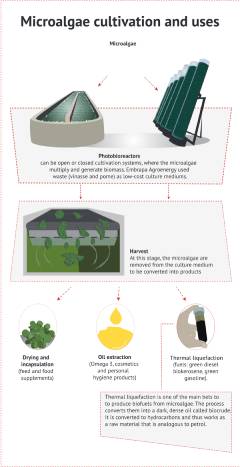 Another advantage of the microalgae tested is that they do not need any input to consume the chemicals present in the Pome. The production cost is low and upon multiplying they form a valuable biomass for different purposes. "We have found high contents of carbohydrates and proteins in this biomass," informs the Embrapa researcher Bruno Brasil, Pascoal's advisor. He recalls that the biomass has such diversified potential of use that new studies should now analyze the most viable and profitable commercial purposes. The microalgae biomass can be used in the industry of animal feed for fish farming, as fertilizer, and even as a high value input for the cosmetic and food industries (see infographic on the left). "A hypothesis is that it has the potential to be used as a plant growth booster, for example," Brasil declares.
Another advantage of the microalgae tested is that they do not need any input to consume the chemicals present in the Pome. The production cost is low and upon multiplying they form a valuable biomass for different purposes. "We have found high contents of carbohydrates and proteins in this biomass," informs the Embrapa researcher Bruno Brasil, Pascoal's advisor. He recalls that the biomass has such diversified potential of use that new studies should now analyze the most viable and profitable commercial purposes. The microalgae biomass can be used in the industry of animal feed for fish farming, as fertilizer, and even as a high value input for the cosmetic and food industries (see infographic on the left). "A hypothesis is that it has the potential to be used as a plant growth booster, for example," Brasil declares.
Carbon credits
Due to the consumption of carbon dioxide (CO2) during the process, the microalgae remove a considerable amount of carbon from the atmosphere. "This paves the path for the sale of carbon credits," the researcher analyzes. as he mentionsthe program from the Brazilian government RenovaBio he emphasizes that "the microalgae have a much higher photosynthesis rate than plants. Thus, the carbon that is biofixed in this process can reward the farmer with carbon credits."
The technology employed is also capable of saving space in the property. It happens because a sequence of ponds treat the effluents produced in milling. The last stage is the aerobics pond, the largest one and also the one destined to the dissolution of the inorganic material. "In short, the treatment with microalgae would make the replacement of this pond with photobioreactors possible, which occupy a smaller area. In addition, it would treat the effluent in much less time, produce valuable biomass, and still bring potential for carbon credits trade," the researcher summarizes.
Pioneering genetic sequencing
The research also involved the sequencing of the mitochondrial genome of Chlamydomonas biconvexa, carried out for the first time. "In addition to corroborate for the identification of the species it offers a new level for the future genetic breeding works on the microalgae," Pascoal states. "Future research will be able to use this molecular data to improve interest characteristics such as higher biomass generation or better performance in effluent treatment, for example," Patrícia Pascoal considers.
The challenges are now the pilot scale tests and industrial scale validation of such biomass, as well as characterization and economic viability studies in order to define ends that add value to the chain.
An ocean of 200mi t of pome per year The largest source of plant oil in the planet, the processing of oil palm generates an ocean of about 200 million tonnes of effluents every year, a volume that would filll around 80,000 Olympic pools. In 2018, Brazil produced 1.6 milion tones of such palm bunches, according to data by the Brazilian Institute of Geography and Statistics (IBGE). For every liter of oil produced, five to seven liters of effluent are generated. Therefore, the discovery of Brazilian microalgae tat can remove inorganic material from pome paves the way for more sustainability and added value for the country, which takes the 9th place in world's top palm oil producing countries. Palm oil is one of the most productive known plant oils, as it yields more oil per planted area than any other species. The fruit supplies 35% os the world demand for this kind of oil while occupying only 10% of the area. In order to produce the same quantity of oil, soybeans would require an area four times larger, for instance. 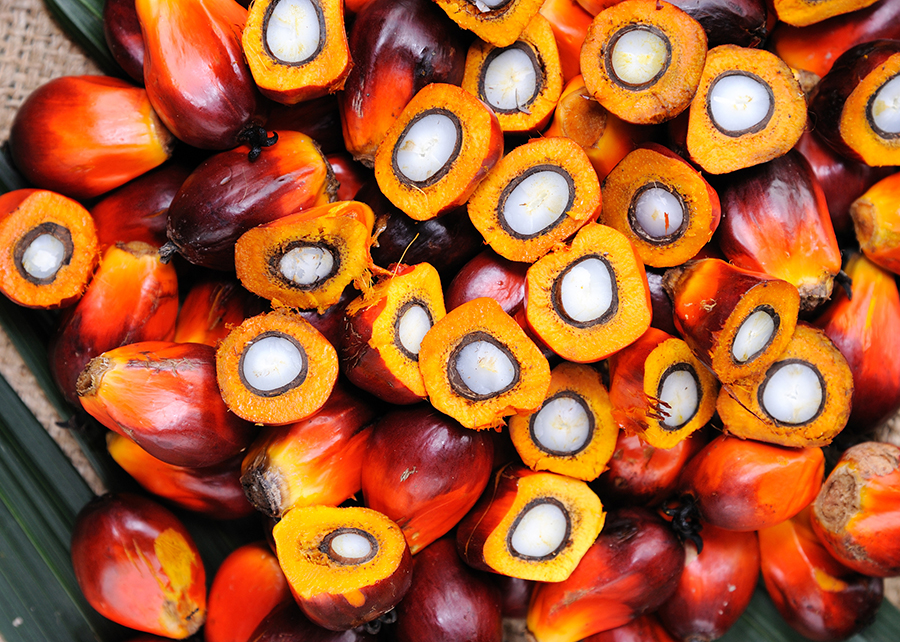
Photo: iStock/slpu9945 Palm oil's social and economic role is relevant as it drives the GDP of emerging countries and involves an expressive quantity of family farmers in its production system. Its use is so diversified that ranges from cookies to shampoo. |
Sugarcane inheritance Chlamydomonas biconvexa Embrapa LBA40 was originally found in the vinasse of a sugarcane plant in the Cerrado region. The presence of the microalgae in that effluent pointed to its potential to process this material. Later on, research with vinasse showed that the strain was in fact efficient to treat the sugarcane effluent. "The presence in the vinasse indicated its tolerance to that effluent, which made it a strong candidate for cultivation in Pome," Patrícia Pascoal reports. In the end, LBA40 presented the best performance in the treatment in comparison with other 16 strains tested in the study. |
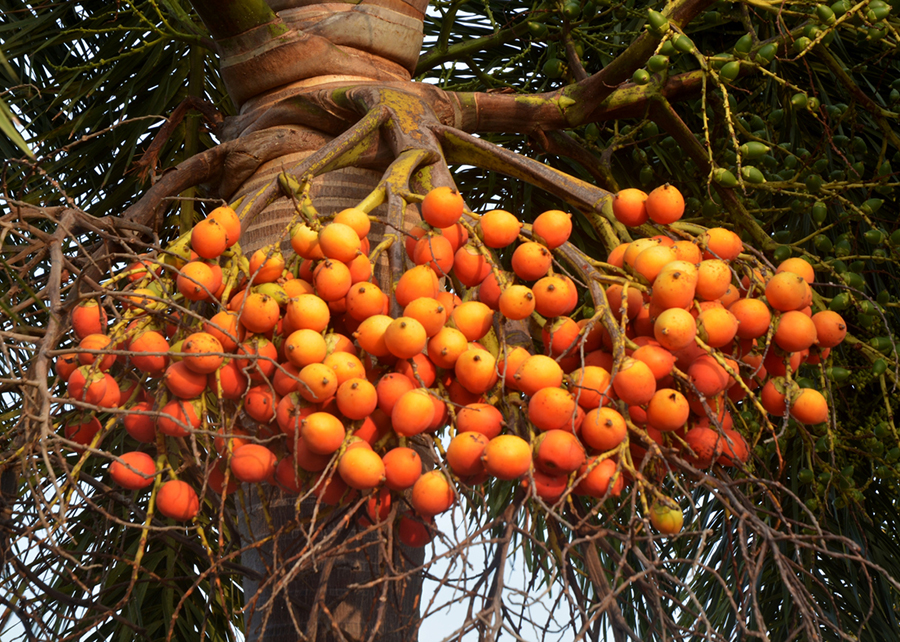 African palm oil program to save the forest
African palm oil program to save the forest
The work was developed within the project "Dende Palm", by the the Studies and Projects Funding Agency (Finep), and coordinated by Embrapa Agroenergy. The project aims to cover the obstacles of African palm oil production chain that prevent its sustainable growth.
African oil palm is a plant from equatorial regions that are warm and humid, which makes its production in Brazil to be concentrated in the Amazon biome, especially in the state of Pará. For this reason, in 2010 the federal government created the Sustainable Palm Oil Production Program (PSOP), establishing that the expansion of the crop should only be made in areas that are already cleared to stop advances over the forest. In this sense, the initiative was successful and the crop that had advanced by 4% over the forest per year dropped this number to about 1% per year in the first four years of implementation.
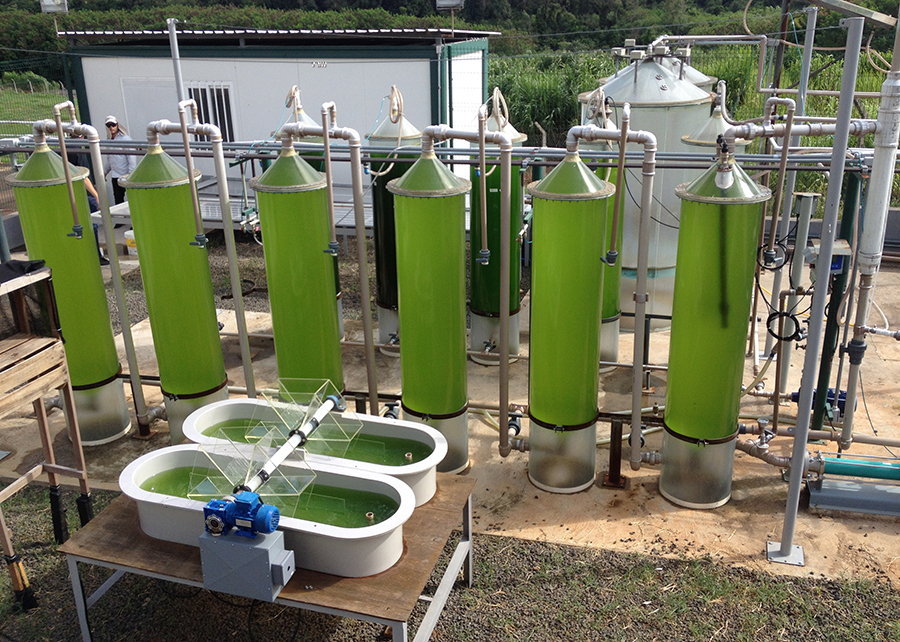
 Another advantage of the microalgae tested is that they do not need any input to consume the chemicals present in the Pome. The production cost is low and upon multiplying they form a valuable biomass for different purposes. "We have found high contents of carbohydrates and proteins in this biomass," informs the Embrapa researcher Bruno Brasil, Pascoal's advisor. He recalls that the biomass has such diversified potential of use that new studies should now analyze the most viable and profitable commercial purposes. The microalgae biomass can be used in the industry of animal feed for fish farming, as fertilizer, and even as a high value input for the cosmetic and food industries (see infographic on the left). "A hypothesis is that it has the potential to be used as a plant growth booster, for example," Brasil declares.
Another advantage of the microalgae tested is that they do not need any input to consume the chemicals present in the Pome. The production cost is low and upon multiplying they form a valuable biomass for different purposes. "We have found high contents of carbohydrates and proteins in this biomass," informs the Embrapa researcher Bruno Brasil, Pascoal's advisor. He recalls that the biomass has such diversified potential of use that new studies should now analyze the most viable and profitable commercial purposes. The microalgae biomass can be used in the industry of animal feed for fish farming, as fertilizer, and even as a high value input for the cosmetic and food industries (see infographic on the left). "A hypothesis is that it has the potential to be used as a plant growth booster, for example," Brasil declares. African palm oil program to save the forest
African palm oil program to save the forest
